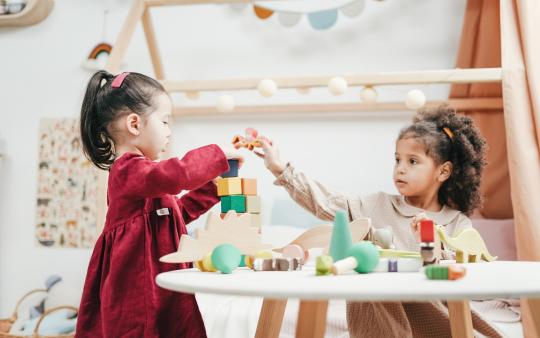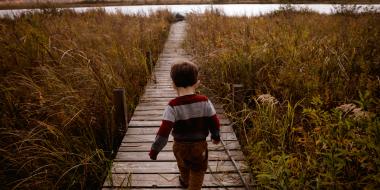Co-authored by Domenique Barbaro
Children were born to play. Though play may seem to be a frivolous activity used by adults to keep children content and entertained, the power of playfulness goes far beyond this. Play is the primary task for children. It is not only a typical childhood attribute, but also the main mechanism behind optimal development. Play allows children to build confidence, creativity, imagination, and develop fine motor movement, decision-making, and problem-solving skills. It also displaces other ways that children may spend time, such as using screens or electronic devices, which are associated with numerous negative health outcomes.
Research shows that play is necessary for social, emotional, and cognitive growth.1 It nurtures the prosocial brain and helps children develop safe and caring relationships with their friends and caregivers. Play promotes language development, and even enhances a child’s brain structure when it’s most malleable.1,2 It also improves the development of self-regulation and executive function, which include skills such as memory, attention, and self-control; play helps children regulate and cope with emotions by releasing tension and reducing anxiety.3 The benefits of play and how it can be incorporated into a child’s day-to-day life are critical to healthy development. Far from being frivolous, play is serious stuff.
BENEFITS AND TYPES OF PLAY
Play can be categorized in various ways. Each form of play comes with its own developmental sequences and associated benefits.
Object Play
This is the most common and popular form of play. It involves an infant or child exploring the properties of toys and objects around them. These explorations can include the use of the hands and mouth and are sensorimotor in nature. This type of play also allows a child to exercise language and communication skills as well as abstract thought, like when children use objects to represent others (e.g., when a child uses a banana as a telephone).1
Physical Play
Also known as locomotor, or rough-and-tumble play, this type of play may begin with basic pat-a-cake, developing into more complex motor skills and free play. Motor skills are not only a critical aspect of development, but are also essential to promoting physical activity in children. Rough-and-tumble play also provides a chance for children to learn how to cooperate and interact socially and take risks and challenge themselves in safe environments.1
Outdoor Play
Outdoor play provides the opportunity for a child to practice sensory integration while having exposure to the benefits of nature. Natural settings can make play more engaging; unstructured outdoor play is seen as one of the most valuable forms of play, since it has a significant impact on a child’s physical activity and hormonal regulation.1,2
Social/Pretend Play
Social and pretend play can be self-directed or can involve another child or adult. Pretend play involves a child’s experimentation with different social roles. It involves dress-up and make-believe scenarios that allow a child to be creative. Play that involves other children allows a child to develop negotiation and cooperation skills, whereas playing with adults is often the earliest form of social play and involves more vocal attunement and facial expressions. Pretend play and having a child use their imagination allows them to develop sophisticated language, improve executive functioning, and develop agency. When it’s self-directed, versus allowing an adult to guide play, a child can initiate and construct roles and social scenarios all on their own. This is important as it allows a child to uncover their own power and independence.1
Community, School, and Home
Children will always take the opportunity to play; parents, educators, health professionals, and the government must ensure these opportunities are available. Equitable and equal opportunities for play must be created for all children regardless of age, ability, race, education, income, or socioeconomic status.
At a community level, green spaces and playgrounds should be incorporated into all neighbourhoods to ensure children have access to safe places for free outdoor play. Whenever possible, promotional strategies such as health infographics, posters, and advertising should also emphasize the power of playfulness in the home, community, and educational settings. It is critical that primary healthcare providers educate parents on the importance of play toward development and emphasize its value, just as they emphasize the value of physical activity, a great diet, and sufficient sleep.

At school, opportunities for free play—both indoor and outdoor—should be incorporated into each school day to give kids the opportunity to be creative with their peers. This fosters healthy social interactions and gives kids a break from the typical adult-guided and structured classroom activities.3 While improving cognitive function and social skills, it’s also fun and relaxing for children to take a break during school to use their imagination. Schools should be well-equipped with the tools necessary to support playfulness, such as simple items for object and pretend play (especially for kindergarten classes), and toys for physical play, such as skipping ropes and balls.
The best part of play is when it’s unstructured and self-directed. This requires less of adults, but does require them to let go of control! Letting your child use their imagination and direct their play not only gives them agency, but also allows them to develop independence and confidence.2 At home, parents can provide spaces for their children to freely play in a self-directed and safe manner. This doesn’t necessarily have to be a playroom, play station or play table. Children don’t need a devoted space—they simply need awareness of the spaces they have available to them for play.
Giving children more space allows them to roam freely and make use of the objects and spaces around them. Providing toys, clothes for dress-up, and other props can also help facilitate object and pretend play. This need not be expensive or complex; the simpler the object, the more a child’s creativity is cultivated. Blocks, pieces of fabric, and even stones can prompt make-believe play. Household objects are wonderful fodder for play; move sharp or electronic items out of reach and allow a child to play with safe kitchen items, such as colanders and whisks. And although it’s best for kids’ development to let them take the lead, they love it when their grown-ups join in. So, get your play on—it’s good for you too!
Nurturing Play at Home
- Fill the sink with sudsy water and invite your little one to wash their toys or dishes, making sure any dishes are free of sharp edges and not easy to break. Just release your expectations of them actually being clean in the end!
- Make some simple playdoh (2 c all-purpose flour, 1 c salt, 1 c cold water) to keep your little one busy with cookie cutters and rolling pins.
- Devote a reachable drawer to kitchen items that are okay for your child to play with, like wooden spoons, colanders, plastic containers, and kitchen cloths.
- Curate a box of dress-up items gleaned from your closet or a thrift store, like silky scarves, fun hats, chunky shoes, and costume jewelry. Make sure there are no choking hazards.
- Go outside! Take turns making scavenger hunts for each other, build forts or snow creatures, or add non-toxic food colouring to a squirt bottle and paint the snow.
There is more to play than building blocks and pat-a-cake. It’s a fun, cost-effective, and valuable way to improve children's social, physical, and emotional health while fostering their social connectedness, confidence, innovation, agency, and creativity. At the end of the day, as important as it is for our little ones, we could all benefit from the power of playfulness.
For references visit ecoparent.ca/TWF/SPRING23
You May Also Like: Why Kids Need True Play for Emotional Development, How Play Helps Kids Succeed and Cope, Outdoor Art and Exploration Play.






